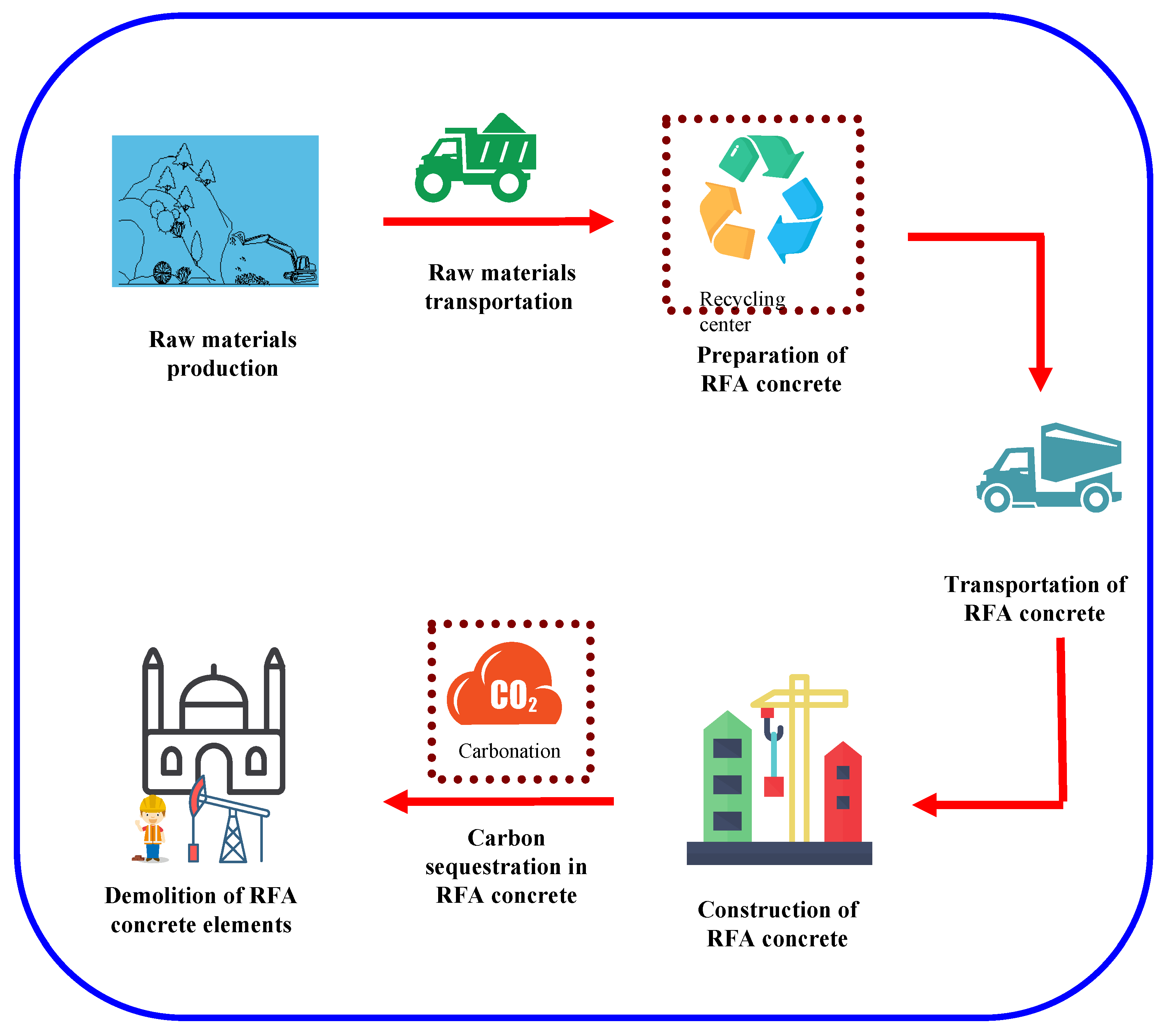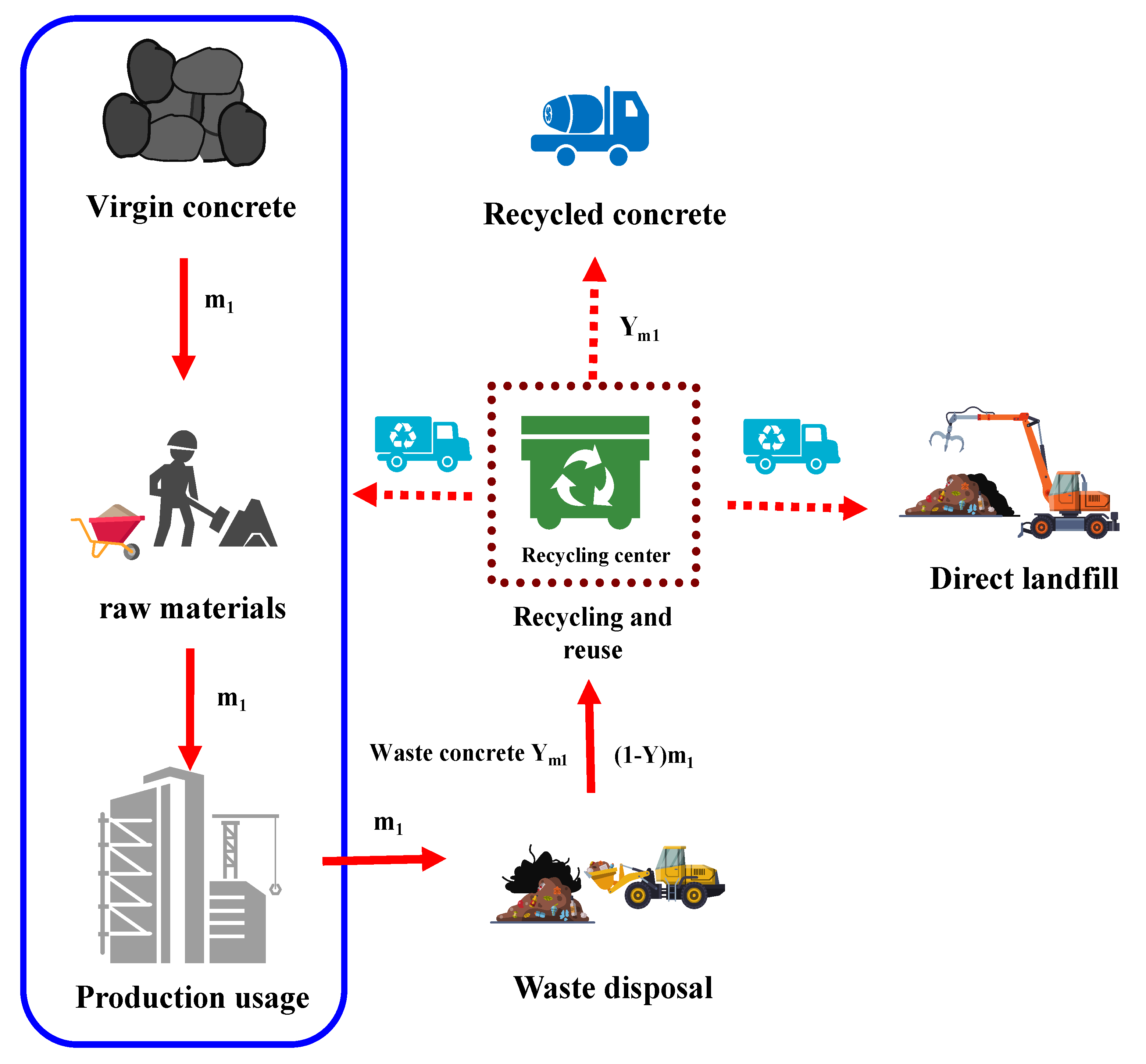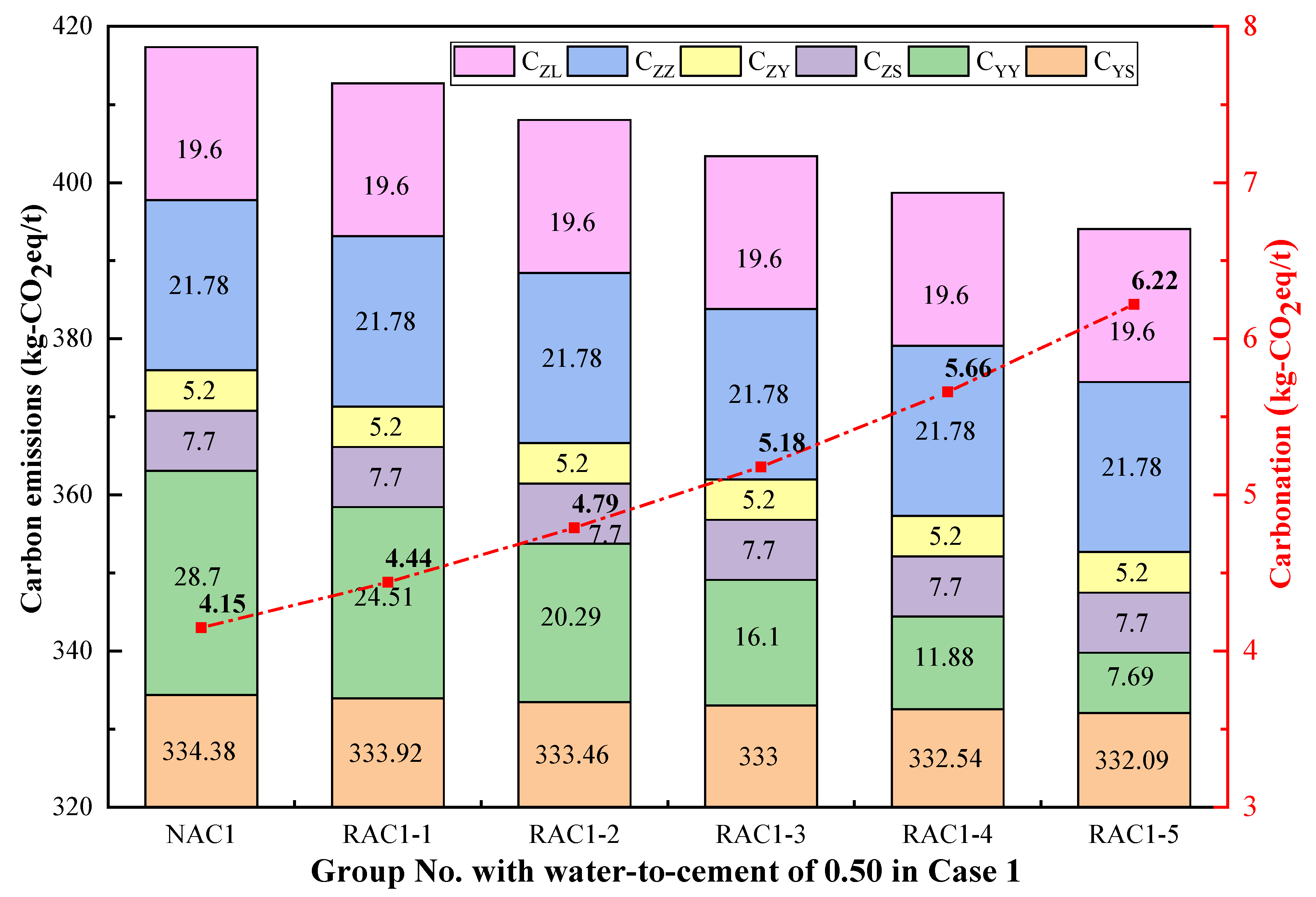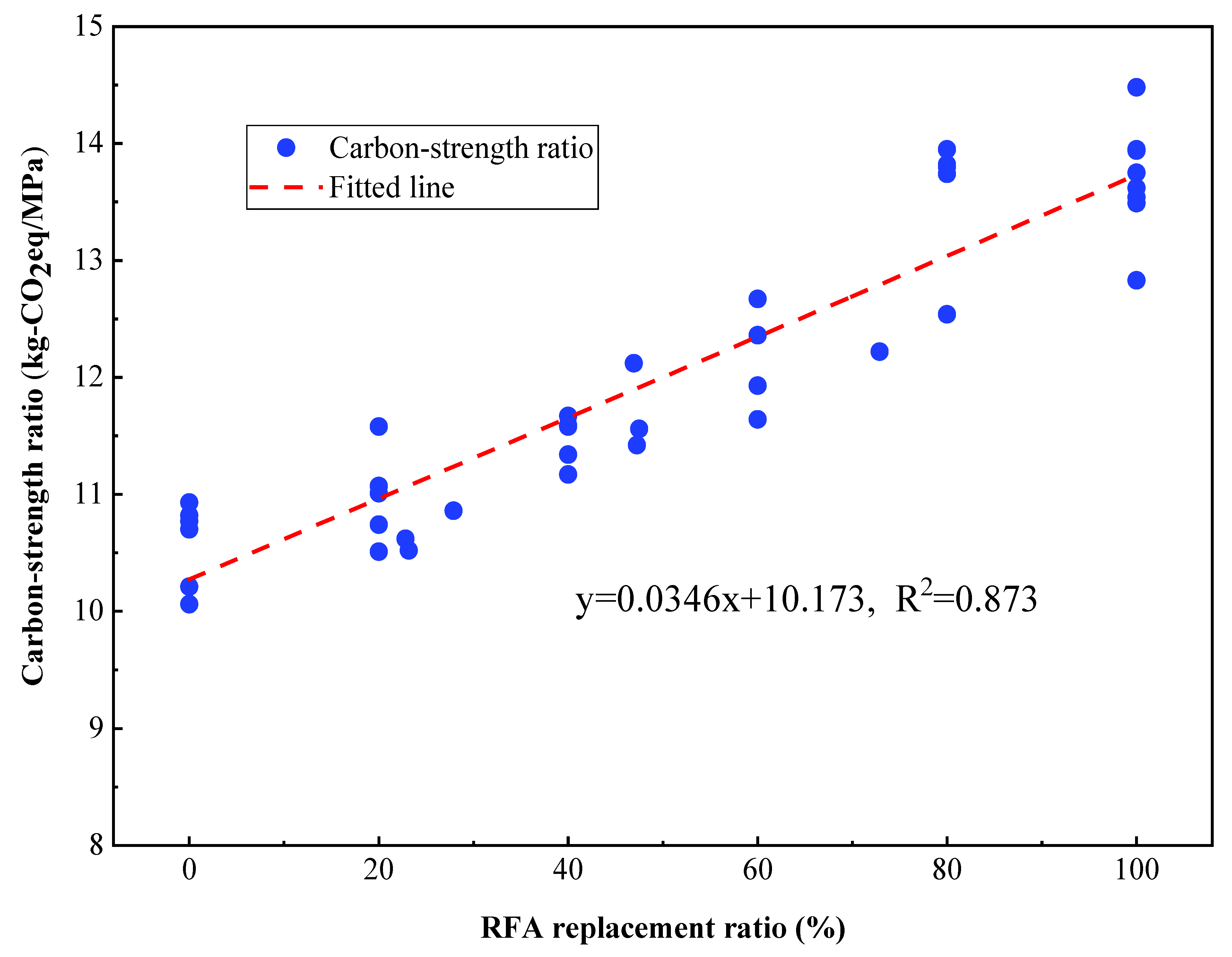Carbon Emission Evaluation of Recycled Fine Aggregate Concrete Based on Life Cycle Assessment
Abstract
1. Introduction
2. Methodology and Quantitative Analysis
2.1. Research Objectives and Scope
2.2. Life Cycle Inventory Data
2.3. Calculation Method of Carbon Emissions
3. Case Study
3.1. Material Parameters
3.2. Life Cycle Carbon Calculation Results
3.3. Effect of Transportation Distance on Carbon Emissions of RFA Concrete
3.4. Spatial Fitting Analysis of RFA Replacement Ratio, 28-Day Cubic Compressive Strength and Carbon Emissions
3.5. Analysis of Carbon-Strength Ratio of RFA Concrete
3.6. Sensitivity Analysis of Influencing Factors
3.6.1. Grey Relational Analysis
3.6.2. Analysis of Variance
3.6.3. Spearman Correlation Analysis
3.6.4. Comparison of Three Correlation Methods
4. Conclusions
Author Contributions
Funding
Conflicts of Interest
Abbreviations
| Abbreviations | Full Name of the Term |
| LCA | Life Cycle Assessment |
| RFA | Recycled Fine Aggregate |
| GRA | Grey Relational Analysis |
| ANOVA | Analysis of Variance |
| SPSS | Statistical Product Service Solutions |
| Cm | The environmental impact factor of recycled aggregates obtained according to the mass allocation method. |
| Mrecycled-material | The mass of recycled aggregates. |
| Mdisposable-material | The mass of waste concrete. |
| Ce | The environmental impact factor of recycled aggregates obtained according to the economic allocation method. |
| E1-money | The market economic value of recycled aggregate. |
| E2-money | The cost of waste concrete. |
| CLC | The total carbon emission of the life cycle of RFA concrete. |
| CYS | The carbon emission in the stages of the raw material extraction and processing. |
| CYY | The carbon emission in the stage of the raw material transportation to the manufacture. |
| CZS | The carbon emission in the stage of RFA concrete manufacturing. |
| CZY | The carbon emission in the stage of transportation to the building site for RFA concrete. |
| CZZ | The carbon emission in the stage of construction of RFA concrete. |
| CZC | The carbon emission in the stage of de-construction or demolition of RFA concrete. |
| CTH | The carbon uptake due to the carbonation of concrete. |
| X | RFA replacement ratio of RFA concrete. |
| Y | 28-day cubic compressive strength of RFA concrete at different RFA replacement ratios (MPa). |
| Z | The amount of CO2 generated per unit of RFA concrete throughout its life cycle (kg CO2-eq). |
References
- Meyer, C. The greening of the concrete industry. Cem. Concr. Compos. 2009, 31, 601–605. [Google Scholar] [CrossRef]
- Vieira, T.; Alves, A.; Brito, J.; Correia, J.R.; Silva, R.V. Durability-related performance of concrete containing fine recycled aggregates from crushed bricks and sanitary ware. Mater. Des. 2016, 90, 767–776. [Google Scholar] [CrossRef]
- Kaza, S.; Yao, L.; Bhada-Tata, P.; Van Woerden, F. What a Waste 2.0-A Global Snapshot of Soild Waste Management to 2050; Urban Development Series; World Bank Group: Washington, DC, USA, 2018; pp. 1–295. [Google Scholar]
- Guo, H.; Shi, C.; Guan, X.; Zhu, J.; Ding, Y.; Ling, T.C. Durability of recycled aggregate concrete—A review. Cem. Concr. Comp. 2018, 89, 251–259. [Google Scholar] [CrossRef]
- Bendixen, M.; Best, J.; Hackney, C.; Iversen, L. Time is running out for sand. Nature 2019, 571, 29–31. [Google Scholar] [CrossRef]
- Xiao, J.; Li, W.; Fan, Y.; Huang, X. An overview of study on recycled aggregate concrete in China (1996–2011). Constr. Build. Mater. 2012, 31, 364–383. [Google Scholar] [CrossRef]
- Huang, B.; Wang, X.; Kua, H.; Geng, Y.; Bleischwitz, R.; Ren, J. Construction and demolition waste management in China through the 3R principle. Resour. Conserv. Recycl. 2018, 129, 36–44. [Google Scholar] [CrossRef]
- Duan, Z.; Hou, S.; Xiao, J.; Li, B. Study on the essential properties of recycled powders from construction and demolition waste. J. Clean. Prod. 2020, 253, 119865. [Google Scholar] [CrossRef]
- Deepak, P.; Bhupendra, S.; Kumar, S.S. Utilization of recycled concrete aggregate in bituminous mixtures: A comprehensive review. Constr. Build. Mater. 2022, 326, 126859. [Google Scholar]
- Li, L.; Zhan, B.J.; Lu, J.; Poon, C.S. Systematic evaluation of the effect of replacing river sand by different particle size ranges of fine recycled concrete aggregates (FRCA) in cement mortars. Constr. Build. Mater. 2019, 209, 147–155. [Google Scholar] [CrossRef]
- Behera, M.; Minocha, A.K.; Bhattacharyya, S.K. Flow behavior, microstructure, strength and shrinkage properties of self-compacting concrete incorporating recycled fine aggregate. Constr. Build. Mater. 2019, 228, 116–819. [Google Scholar] [CrossRef]
- Leite, M.B.; Santana, V.M. Evaluation of an experimental mix proportion study and production of concrete using fine recycled aggregate. J. Build. Eng. 2019, 21, 243–253. [Google Scholar] [CrossRef]
- Evangelista, L.; Brito, J.D. Mechanical behaviour of concrete made with fine recycled concrete aggregates. Cem. Concr. Comp. 2007, 29, 397–401. [Google Scholar] [CrossRef]
- Martínez, I.; Etxeberria, M.; Pavón, E.; Díaz, E. Influence of demolition waste fine particles on the properties of recycled aggregate masonry mortar. Int. J. Civ. Eng. 2018, 16, 1213–1226. [Google Scholar] [CrossRef]
- Gao, D.; Gu, Z.; Pang, Y.; Yang, L. Mechanical properties of recycled fine aggregate concrete incorporating different types of fibers. Constr. Build. Mater. 2021, 298, 123732. [Google Scholar] [CrossRef]
- Xiao, J.; Wang, C.; Ding, T.; Akbarnezhad, A. A recycled aggregate concrete high-rise building: Structural performance and embodied carbon footprint. J. Clean. Prod. 2018, 199, 868–881. [Google Scholar] [CrossRef]
- Tsujino, M.; Noguchi, T.; Tamura, M.; Kanematsu, M.; Maruyama, I. Application of conventionally recycled coarse aggregate to concrete structure by surface modification treatment. J. Adv. Concr. Technol. 2007, 5, 13–25. [Google Scholar] [CrossRef]
- Shi, D.; Shi, Q. Study on mechanical properties and mesoscopic numerical simulation of recycled concrete. Sustainability 2022, 14, 12125. [Google Scholar] [CrossRef]
- Yildirim, S.T.; Meyer, C.; Herfellner, S. Effects of internal curing on the strength, drying shrinkage and freeze-thaw resistance of concrete containing recycled concrete aggregates. Constr. Build. Mater. 2015, 91, 288–296. [Google Scholar] [CrossRef]
- Yoda, K.; Shintani, A. Building application of recycled aggregate concrete for upper-ground structural elements. Constr. Build. Mater. 2014, 67, 379–385. [Google Scholar] [CrossRef]
- Marian, S.; Dan, V.; Luis, F. Comparative carbon emission assessments of recycled and natural aggregate concrete: Environmental influence of cement content. Geosci. Front. 2021, 12, 101235. [Google Scholar]
- Lage, I.M.; Burgo, P.V.; Lizancos, M.V. Sustainability evaluation of concretes with mixed recycled aggregate based on holistic approach: Technical, economic and environmental analysis. Waste. Manag. 2020, 104, 9–19. [Google Scholar] [CrossRef] [PubMed]
- Sereewatthanawut, I.; Prasittisopin, L. Environmental evaluation of pavement system incorporating recycled concrete aggregate. Int. J. Pavement Res. Technol. 2020, 13, 455–465. [Google Scholar] [CrossRef]
- Marinković, S.; Radonjanin, V.; Malešev, M.; Ignjatović, I. Comparative environmental assessment of natural and recycled aggregate concrete. Waste Manag. 2010, 30, 2255–2264. [Google Scholar] [CrossRef]
- Zhang, Y.; Luo, W.; Wang, J.; Wang, Y.; Xu, Y.; Xiao, J. A review of life cycle assessment of recycled aggregate concrete. Constr. Build. Mater. 2019, 209, 115–125. [Google Scholar] [CrossRef]
- Kawai, K.; Sugiyama, T.; Kobayashi, K.; Sano, S. Inventory data and case studies for environmental performance evaluation of concrete structure construction. J. Adv. Concr. Technol. 2005, 3, 435–456. [Google Scholar] [CrossRef]
- ISO. ISO, 14044; Environmental Management--Life Cycle Assessment--Requirements and Guidelines. International Organization for Standardization: Geneva, Switzerland, 2006; p. 2006.
- Chen, C.; Habert, G.; Bouzidi, Y.; Jullien, A.; Ventura, A. LCA allocation procedure used as an incitative method for waste recycling: An application to mineral additions in concrete. Resour. Conserv. Recycl. 2010, 54, 1231–1240. [Google Scholar] [CrossRef]
- Werner, F.; Richter, K. Economic allocation in LCA: A case study about aluminium window frames. Int. J. Life Cycle Assess. 2000, 5, 79–83. [Google Scholar] [CrossRef]
- Zhang, Y.; Xu, Y.; Yao, Z.; Wang, L. Effect of mix design methods on life cycle assessment of recycled aggregate concrete. J. Zhejiang Univ. Technol. 2020, 48, 648–653. (In Chinese) [Google Scholar]
- Xiao, J.; Li, A.; Ding, T. Life cycle assessment on CO2 emission for recycled aggregate concrete. J. Southeast Univ. (Nat. Sci. Ed.) 2016, 46, 1088–1092. (In Chinese) [Google Scholar]
- Xing, W.; Tam, V.W.; Le, K.N.; Butera, A.; Hao, J.L.; Wang, J. Effects of mix design and functional unit on life cycle assessment of recycled aggregate concrete: Evidence from CO2 concrete. Constr. Build. Mater. 2022, 348, 128712. [Google Scholar] [CrossRef]
- Gong, X.; Nie, Z.; Wang, Z.; Cui, S.; Gao, F.; Zuo, T. Life cycle energy consumption and carbon dioxide emission of residential building designs in Beijing. J. Ind. Ecol. 2012, 16, 576–587. [Google Scholar] [CrossRef]
- Mahmood, W.; Khan, A.R.; Ayub, T. Carbonation resistance in ordinary Portland cement concrete with and without recycled coarse aggregate in natural and simulated environment. Sustainability 2021, 14, 437. [Google Scholar] [CrossRef]
- Pade, C.; Guimaraes, M. The CO2 uptake of concrete in a 100 year perspective. Cem. Concr. Res. 2007, 37, 1348–1356. [Google Scholar] [CrossRef]
- Yang, K.H.; Seo, E.A.; Tae, S.H. Carbonation and CO2 uptake of concrete. Environ. Impact Asses. 2014, 46, 43–52. [Google Scholar] [CrossRef]
- Sun, Y.; Li, D.; Xu, Y.; Huang, H. Experimental research on mechanical properties and durability of recycled fine aggregate concrete for actual production. Build. Struct. 2019, 49, 81–84+11. (In Chinese) [Google Scholar]
- Kirthika, S.K.; Singh, S.K. Durability studies on recycled fine aggregate concrete. Constr. Build. Mater. 2020, 250, 118850. [Google Scholar] [CrossRef]
- Fan, C.C.; Huang, R.; Hwang, H.; Chao, S.J. Properties of concrete incorporating fine recycled aggregates from crushed concrete wastes. Constr. Build. Mater. 2016, 112, 708–715. [Google Scholar] [CrossRef]
- Damineli, B.L.; Kemeid, F.M.; Aguiar, P.S.; John, V.M. Measuring the eco-efficiency of cement use. Cem. Concr. Comp. 2010, 32, 555–562. [Google Scholar] [CrossRef]
- Knoeri, R.; Silvestre, J.D.; Brito, J.; Ahmed, H. Effect of incorporation of high volume of recycled concrete aggregates and fly ash on the strength and global warming potential of concrete. J. Clean. Prod. 2017, 166, 485–502. [Google Scholar]
- Wen, K. The proof of a new modified grey relational grade. Grey Syst. Theory Appl. 2016, 6, 180–186. [Google Scholar] [CrossRef]
- You, M.L.; Shu, C.M.; Chen, W.T.; Shyu, M.L. Analysis of cardinal grey relational grade and grey entropy on achievement of air pollution reduction by evaluating air quality trend in Japan. J. Clean. Prod. 2017, 142, 3883–3889. [Google Scholar] [CrossRef]
- Fausto, M.G.; Alexander, L.B.; Enrique, D.C. A novel approach for the control of grain size distributions based on variance analysis. Constr. Build. Mater. 2021, 285, 122748. [Google Scholar]
- Chen, L.; Zhou, W.; Yu, C.; Shen, F. SPSS variance analysis-based teenager physical health promoting strategy research. Indian J. Biotechnol. 2014, 10, 1156–1161. [Google Scholar]
- Michael, S.; Melvin, V. Sequential estimation of Spearman rank correlation using Hermite series estimators. J. Multivar. Aanal. 2021, 186, 104783. [Google Scholar]






| Quantity (kg) | Cost (CNY) | Allocation Factor | |
|---|---|---|---|
| Waste concrete | 1000 | 143.48 | 143.48/175.76 × 100% = 81.63% |
| Recycled coarse aggregates | 650 | 14.29 | 14.29/175.76 × 100% = 8.13% |
| Recycled fine aggregates | 330 | 17.99 | 17.99/175.76 × 100% = 10.24% |
| Total | -- | 175.76 | 100% |
| RFA Concrete List | Cement [24] | Natural Coarse Aggregate [30] | Natural Fine Aggregate [32] | Recycled Fine Aggregate [25] | Superplasticizer [32] | Water [30] |
|---|---|---|---|---|---|---|
| Carbon emission factor (kg-CO2eq/t) | 861 | 3.70 | 4.00 | 0.598 | 1150 | 0.213 |
| Transportation machinery | Cement truck | Dry bulk carrier | Dry bulk carrier | Diesel trucks | Diesel trucks | -- |
| Transport distance/km | 20 | 380 | 300 | 10 | 10 | 0 |
| Transportation carbon emission factor kg-CO2eq/(t∙km) | 0.111 | 0.0134 | 0.0134 | 0.107 | 0.107 | -- |
| RFA concrete preparation of carbon emissions [30] (kg-CO2eq/m3) | 7.7 | |||||
| RFA concrete construction carbon emissions [31] (kg-CO2eq/m3) | 21.78 | |||||
| RFA concrete carbon emissions from construction and demolition [31] (kg-CO2eq/m3) | 19.6 | |||||
| Group NO. | RFA Replacement Ratio/wt% | Water-to-Cement Ratio | Materials/(kg/m3) | 28-Days Cubic Compressive Strength/MPa | |||||
|---|---|---|---|---|---|---|---|---|---|
| Cement | Natural Coarse Aggregate | Natural Fine Aggregate | Recycled Fine Aggregate | Free Water | Additional Water | ||||
| NAC1 | 0 | 0.50 | 380 | 1203 | 677 | 0 | 190 | 0 | 41.45 |
| RAC1-1 | 20 | 0.50 | 380 | 1203 | 542 | 135 | 190 | 10 | 39.39 |
| RAC1-2 | 40 | 0.50 | 380 | 1203 | 406 | 271 | 190 | 20 | 36.78 |
| RAC1-3 | 60 | 0.50 | 380 | 1203 | 271 | 406 | 190 | 30 | 34.15 |
| RAC1-4 | 80 | 0.50 | 380 | 1203 | 135 | 542 | 190 | 41 | 35.03 |
| RAC1-5 | 100 | 0.50 | 380 | 1203 | 0 | 677 | 190 | 51 | 29.15 |
| NAC2 | 0 | 0.55 | 345 | 1203 | 677 | 0 | 190 | 0 | 36.01 |
| RAC2-1 | 20 | 0.55 | 345 | 1203 | 542 | 135 | 190 | 10 | 34.51 |
| RAC2-2 | 40 | 0.55 | 345 | 1203 | 406 | 271 | 190 | 20 | 32.71 |
| RAC2-3 | 60 | 0.55 | 345 | 1203 | 271 | 406 | 190 | 30 | 26.33 |
| RAC2-4 | 80 | 0.55 | 345 | 1203 | 135 | 542 | 190 | 41 | 26.68 |
| RAC2-5 | 100 | 0.55 | 345 | 1203 | 0 | 677 | 190 | 51 | 25.46 |
| NAC3 | 0 | 0.60 | 308 | 1203 | 677 | 0 | 185 | 0 | 32.63 |
| RAC3-1 | 20 | 0.60 | 308 | 1203 | 542 | 135 | 185 | 10 | 30.08 |
| RAC3-2 | 40 | 0.60 | 308 | 1203 | 406 | 271 | 185 | 20 | 29.76 |
| RAC3-3 | 60 | 0.60 | 308 | 1203 | 271 | 406 | 185 | 30 | 29.36 |
| RAC3-4 | 80 | 0.60 | 308 | 1203 | 135 | 542 | 185 | 41 | 24.47 |
| RAC3-5 | 100 | 0.60 | 308 | 1203 | 0 | 677 | 185 | 51 | 23.99 |
| NAC4 | 0 | 0.65 | 277 | 1203 | 677 | 0 | 180 | 0 | 29.88 |
| RAC4-1 | 20 | 0.65 | 277 | 1203 | 542 | 135 | 180 | 10 | 29.05 |
| RAC4-2 | 40 | 0.65 | 277 | 1203 | 406 | 271 | 180 | 20 | 27.12 |
| RAC4-3 | 60 | 0.65 | 277 | 1203 | 271 | 406 | 180 | 30 | 24.72 |
| RAC4-4 | 80 | 0.65 | 277 | 1203 | 135 | 542 | 180 | 41 | 22.52 |
| RAC4-5 | 100 | 0.65 | 277 | 1203 | 0 | 677 | 180 | 51 | 21.92 |
| NAC5 | 0 | 0.70 | 257 | 1203 | 677 | 0 | 180 | 0 | 27.88 |
| RAC5-1 | 20 | 0.70 | 257 | 1203 | 542 | 135 | 180 | 10 | 28.05 |
| RAC5-2 | 40 | 0.70 | 257 | 1203 | 406 | 271 | 180 | 20 | 26.27 |
| RAC5-3 | 60 | 0.70 | 257 | 1203 | 271 | 406 | 180 | 30 | 23.82 |
| RAC5-4 | 80 | 0.70 | 257 | 1203 | 135 | 542 | 180 | 41 | 21.07 |
| RAC5-5 | 100 | 0.70 | 257 | 1203 | 0 | 677 | 180 | 51 | 21.27 |
| Group NO. | RFA Replacement Ratio/wt% | Water-to-Cement Ratio | Materials/(kg/m3) | 28-Days Cubic Compressive Strength/MPa | |||||
|---|---|---|---|---|---|---|---|---|---|
| Cement | Natural Coarse Aggregate | Natural Fine Aggregate | Recycled Fine Aggregate | Water | Superplasticizer | ||||
| NAC6 | 0 | 0.50 | 330.0 | 1215.0 | 720 | 0 | 165.0 | 1.65 | 36.2 |
| RAC6-1 | 27.9 | 0.50 | 330.6 | 1160.1 | 504 | 195 | 165.3 | 1.65 | 36.8 |
| RAC6-2 | 47.3 | 0.50 | 331.0 | 1124.0 | 360 | 323 | 166.0 | 1.66 | 33.8 |
| RAC6-3 | 72.9 | 0.50 | 331.5 | 1077.8 | 180 | 484 | 165.8 | 1.66 | 31.7 |
| RAC6-4 | 100 | 0.50 | 332 | 1032.0 | 0 | 645 | 166.0 | 1.66 | 30.1 |
| Group NO. | RFA Replacement Ratio/wt% | Water-to-Cement Ratio | Materials/(kg/m3) | 28-Days Cubic Compressive Strength/MPa | |||||
|---|---|---|---|---|---|---|---|---|---|
| Cement | Natural Coarse Aggregate | Natural Fine Aggregate | Recycled Fine Aggregate | Water | Superplasticizer | ||||
| NAC7 | 0 | 0.35 | 449 | 898 | 898 | 0 | 157 | 4.5 | 53.12 |
| RAC7-1 | 27.9 | 0.35 | 449 | 898 | 673 | 199 | 157 | 4.5 | 48.34 |
| RAC7-2 | 72.9 | 0.35 | 449 | 898 | 449 | 397 | 157 | 4.5 | 41.97 |
| RAC7-3 | 100 | 0.35 | 449 | 898 | 0 | 794 | 157 | 4.5 | 34.75 |
| RAC7-4 | 23.17 | 0.35 | 449 | 898 | 673 | 203 | 157 | 4.5 | 49.64 |
| RAC7-5 | 47.49 | 0.35 | 449 | 898 | 449 | 406 | 157 | 4.5 | 48.52 |
| RAC7-6 | 100 | 0.35 | 449 | 898 | 0 | 813 | 157 | 4.5 | 46.73 |
| Independent Variables | Class III Sum of Squares | Degree of Freedom | Mean Square | F-Value | Significance (p-Value) |
|---|---|---|---|---|---|
| Water-to-cement ratio | 240,349.66 | 4 | 60,087.42 | 17,535.68 | <0.001 |
| RFA replacement ratio | 6792.18 | 5 | 1358.44 | 396.44 | <0.001 |
| Transportation distance | 983.89 | 4 | 245.97 | 71.78 | <0.001 |
| Independent Variables | Number of Samples (N-Values) | Correlation Coefficient | Significance (p-Value) |
|---|---|---|---|
| Water-to-cement ratio | 150 | −0.978 | <0.001 |
| RFA replacement ratio | 150 | −0.202 | 0.013 |
| Transportation distance | 150 | 0.068 | 0.409 |
Publisher’s Note: MDPI stays neutral with regard to jurisdictional claims in published maps and institutional affiliations. |
© 2022 by the authors. Licensee MDPI, Basel, Switzerland. This article is an open access article distributed under the terms and conditions of the Creative Commons Attribution (CC BY) license (https://creativecommons.org/licenses/by/4.0/).
Share and Cite
Lei, B.; Yu, L.; Chen, Z.; Yang, W.; Deng, C.; Tang, Z. Carbon Emission Evaluation of Recycled Fine Aggregate Concrete Based on Life Cycle Assessment. Sustainability 2022, 14, 14448. https://doi.org/10.3390/su142114448
Lei B, Yu L, Chen Z, Yang W, Deng C, Tang Z. Carbon Emission Evaluation of Recycled Fine Aggregate Concrete Based on Life Cycle Assessment. Sustainability. 2022; 14(21):14448. https://doi.org/10.3390/su142114448
Chicago/Turabian StyleLei, Bin, Linjie Yu, Zhiyu Chen, Wanying Yang, Cheng Deng, and Zhuo Tang. 2022. "Carbon Emission Evaluation of Recycled Fine Aggregate Concrete Based on Life Cycle Assessment" Sustainability 14, no. 21: 14448. https://doi.org/10.3390/su142114448
APA StyleLei, B., Yu, L., Chen, Z., Yang, W., Deng, C., & Tang, Z. (2022). Carbon Emission Evaluation of Recycled Fine Aggregate Concrete Based on Life Cycle Assessment. Sustainability, 14(21), 14448. https://doi.org/10.3390/su142114448








